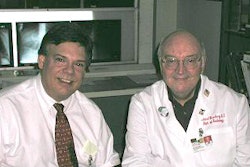Self-referral is robbing imaging residents of teaching materials, according to a survey of 80 residency program directors. However, these same directors are attempting to address the problem and preserve access to clinical cases.
"The Association of Program Directors in Radiology (APDR) has become concerned that (the) self-referral pattern of practice may affect the training of future radiologists," wrote Dr. Michael Shortsleeve and Dr. William Herring in the Journal of the American College of Radiology. To gain a better understanding of the impact of self-referral on residents, they conducted a Web-based survey of 186 accredited diagnostic radiology programs (JACR, May 2005, Vol. 2:5, pp. 415-417).
Of the 186 program directors queried, 43% responded (one response per program director), with the majority (55%) coming from universities, explained Shortsleeve, who is from Mount Auburn Hospital in Cambridge, MA. Herring is from Albert Einstein Medical Center in Philadelphia.
According to 65% of the respondents, self-referral affected their residency programs. Among that group, 90% stated that the impact was negative, mainly because of the loss of clinical material for teaching purposes. The hardest hit areas were obstetric ultrasound, nuclear cardiology, and vascular interventional radiology, with the latter bearing the greatest burden.
"Cardiologists and vascular surgeons have independently contributed to the loss of clinical experience ... because the shared-service concept has not been successful in vascular interventional radiology," the authors wrote.
Three strategies have been employed to deal with this issue, some more successfully than others. According to the survey, 27% of the respondents said they have tried to outright prevent the credentialing of nonradiologists, but without much luck.
Sixty-one percent said they have tried to institute the "shared-service concept," mentioned above. This tactic generally involved joint academic appointments and/or collaborative research. However, the authors reported that this route has only been advantageous in a minority of programs.
Most program directors (76%) said they have sought to develop cooperative, collegial relationships. Shortsleeve and Herring cited a successful nuclear cardiology program in which attending cardiologists and radiologists oversee "readout" sessions with cardiology fellows and imaging residents.
Finally, program directors said they have taken advantage of the Residency Review Committee's six-month rule that allows a resident to spend six months (out of 48) on rotation at an affiliated site.
"Historically, this strategy has been commonly used to enhance experience in pediatric radiology," the authors explained. "More recently, this strategy has been pursued to compensate for the loss of obstetric ultrasound experience."
By Shalmali Pal
AuntMinnie.com staff writer
June 7, 2005
Related Reading
Radiology residents can accurately evaluate after-hours head CTs for stroke, May 20, 2005
As more referrers demand leases, rads hope for legal crackdown, May 5, 2005
U.S. Congress hears debate over federal imaging standards, March 17, 2005
ACR to pitch Congress on 'designated physician imagers' for Medicare, January 6, 2005
Copyright © 2005 AuntMinnie.com


















